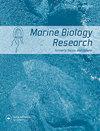模拟氰化物捕鱼:短期氰化物暴露在三种不同的两性珊瑚物种中的光合作用
IF 1.2
4区 生物学
Q4 ECOLOGY
引用次数: 0
摘要
自20世纪60年代以来,观赏观赏鱼的需求稳步增长,因此氰化物捕捞尽管被禁止,但仍然是一种流行的捕捞方法。这对东南亚的珊瑚礁构成了严重威胁。本研究旨在研究三种不同硬珊瑚群落(分支生长形式Pocillopora damicornis和Seriatopora hystrix和massive Porites lobata)对氰化物暴露先高后低的短期应激反应。实验是在印度尼西亚西苏门答腊皮耶岛海洋保护区的珊瑚礁和德国ZMT的水族馆设施进行的。采用dive - pam荧光计对全息生物进行体内应力评估。施用氰化物后,所有物种的光合效率均显著降低,但大型物种的ΔF/Fm′值明显降低。在不含氰的水中三天后,三种珊瑚的Fv/Fm均恢复到初始值,但长叶珊瑚除外。38天后实验结束,未发现漂白或变色现象。特别是印度尼西亚的珊瑚礁,有大量的珊瑚,因此可能受到氰化物捕捞的严重影响,因为这些珊瑚礁的水滞留时间比主要由分枝珊瑚组成的珊瑚礁更长。这可能会对海洋保护区不同珊瑚礁部分的管理产生影响。本文章由计算机程序翻译,如有差异,请以英文原文为准。
Simulating cyanide fishing: photosynthetic effects of short-term cyanide exposure in three different hermatypic coral species
ABSTRACT Since the 1960s the demand for ornamental aquarium fish has grown steadily and consequently cyanide fishing is still a popular fishing method despite its prohibition. This poses a severe threat to coral reefs in Southeast Asia. This study aimed to investigate the short-term stress reaction on photosynthetic yield in the tissues of three different hard coral colonies (branching growth forms Pocillopora damicornis and Seriatopora hystrix, and massive Porites lobata) to initially high and then decreasing cyanide exposure, mimicking cyanide fishing by fishermen. Experiments were performed both in situ in the coral reefs of the Marine Protected Area Pulau Pieh, West Sumatra, Indonesia, and in the aquaria facilities of ZMT in Germany. A Diving-PAM fluorometer was used for in vivo stress assessment of the holobiont. While in all species the photosynthetic efficiency was significantly reduced right after cyanide application, the massive species displayed much lower ΔF/Fm’ values. After three days in cyanide-free water all three coral species recovered to initial values of Fv/Fm, except for P. lobata. No bleaching or discolouration was detected by the conclusion of the experiment after 38 days. Especially Indonesian reefs with massive corals may be therefore more severely impacted by cyanide fishing since the retention time of the water in these reefs is longer than in reefs that consist primarily of branching corals. This might have implications for the management of different reef parts of the MPA.
求助全文
通过发布文献求助,成功后即可免费获取论文全文。
去求助
来源期刊

Marine Biology Research
生物-海洋与淡水生物学
CiteScore
2.10
自引率
0.00%
发文量
55
审稿时长
6-12 weeks
期刊介绍:
Marine Biology Research (MBRJ) provides a worldwide forum for key information, ideas and discussion on all areas of marine biology and biological oceanography. Founded in 2005 as a merger of two Scandinavian journals, Sarsia and Ophelia, MBRJ is based today at the Institute of Marine Research, Bergen, Norway. The Journal’s scope encompasses basic and applied research from all oceans and marine habitats and on all marine organisms, the main criterium for acceptance being quality.
 求助内容:
求助内容: 应助结果提醒方式:
应助结果提醒方式:


